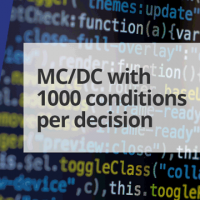If you’ve managed to get to 100% MC/DC, does that mean you’ve tested 100% of your requirements?
Remember that 100% MC/DC means that all of the Boolean decisions have been exercised and that entry and exit of each function has been covered. Requirements will typically govern input-output relationships for the whole function. For example, consider the function:
int perc_mix( int perc, int p0, int p100 ) {
int result;
if( perc < 0 ) {
result = p0;
} else if( perc > 100 ) {
result = p100;
} else {
result = ((p0 * perc) / 100) + ((p100 * ( 100-perc )) / 100);
}
return result;
}
And its requirements:
1: at perc=100 or over, return p100
2: at perc=0 or below, return p0
3: at perc between 0 and 100, return a linear weighted mean of p0 and p100, with the weight p0=1, p100=0 at perc=0 and p0=0, p100=1 at perc=100.
A test suite of perc=-50, perc=0, perc=100, perc=150 achieves full MC/DC but does nothing to exercise requirement 3. (Hopefully the tests have been constructed with differing values of p0 and p100, so that the error in the else-branch of the implementation can be found.) To demonstrate that you’ve tested 100% of your requirements, you need to show:
- That you have a test for 100% of your requirements;
- That 100% of your tests actually test a requirement;
- That every test passes.
Notice that these can be achieved by review – MC/DC is not playing a part here.
So what is MC/DC doing? Once you’ve met the above conditions and you also achieve 100% MC/DC, you will know that your tests have exercised all of the decisions and conditions in your application.

 Rapita System Announces New Distribution Partnership with COONTEC
Rapita System Announces New Distribution Partnership with COONTEC
 Rapita partners with Asterios Technologies to deliver solutions in multicore certification
Rapita partners with Asterios Technologies to deliver solutions in multicore certification
 SAIF Autonomy to use RVS to verify their groundbreaking AI platform
SAIF Autonomy to use RVS to verify their groundbreaking AI platform
 RVS gets a new timing analysis engine
RVS gets a new timing analysis engine
 How to measure stack usage through stack painting with RapiTest
How to measure stack usage through stack painting with RapiTest
 What does AMACC Rev B mean for multicore certification?
What does AMACC Rev B mean for multicore certification?
 How emulation can reduce avionics verification costs: Sim68020
How emulation can reduce avionics verification costs: Sim68020
 How to achieve multicore DO-178C certification with Rapita Systems
How to achieve multicore DO-178C certification with Rapita Systems
 How to achieve DO-178C certification with Rapita Systems
How to achieve DO-178C certification with Rapita Systems
 Certifying Unmanned Aircraft Systems
Certifying Unmanned Aircraft Systems
 DO-278A Guidance: Introduction to RTCA DO-278 approval
DO-278A Guidance: Introduction to RTCA DO-278 approval
 Avionics Certification Q&A: CERT TALK (with Consunova and Visure)
Avionics Certification Q&A: CERT TALK (with Consunova and Visure)


















